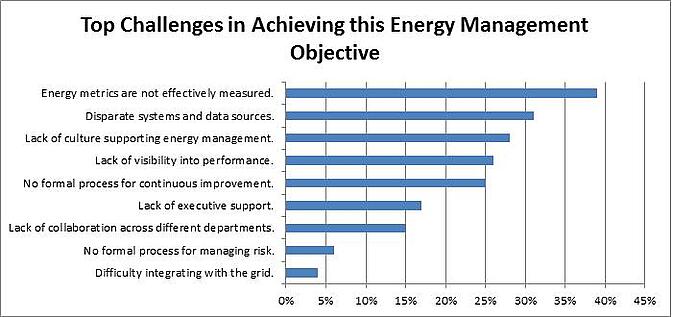Today, many industrial companies are facing similar challenges around improving energy efficiency, but not all have an optimal strategy for handling them. According to LNS's Industrial Energy Management Survey, three of the most common energy management challenges companies are facing today are measuring metrics, managing disparate systems and data sources, and dealing with a lack of supportive company culture around energy management.
While the first two of these challenges are commonly addressed through IT solutions, often in the form of an industrial energy management (IEM) software solution implementation, the last involves leveraging the experience of what can be an overlooked company resource: Its people. Particularly, those on the shop floor with the most knowledge of site level-operations.
Drawing upon LNS survey data and follow-up conversations with several energy management leaders, in this post we’ll examine how a more collaborative company culture around energy management and leveraging the experience of shop-floor leaders can better align corporate and local energy management goals more closely, and be a key driver for improved operational efficiency.
Examining Key Industrial Energy Management Trends and Data
In the past three months, over 150 energy executives have completed the 2012-2013 LNS Research Industrial Energy Management Survey. Specifically, this survey focuses on the objectives, challenges, and benchmark data that are top-of-mind for executives and other leaders making energy management decisions. As shown in the graph below, when asked about their challenges faced in energy management, the top three responses included accurately measuring energy metrics (39% of respondents), having disparate systems and data sources (31%) and a lack of culture supporting energy management (28%).

It’s notable that in many follow-up conversations with survey participants we heard similar sentiments regarding the third challenge around culture again and again, particularly from local energy leaders. These local energy leaders can generally be characterized as long-term employees with engineering/automation backgrounds, having deep knowledge of plant operations, and having a passion for energy efficiency.
Providing insight as to why nearly 30% of survey respondents identified culture as a roadblock to optimized energy management, local energy leaders often felt a supportive culture was absent around energy. In many cases they expressed a desire to do much more at the site level, but said that a lack of executive focus on local energy management prevented them from taking further initiatives.
Aligning Site-Level and Corporate Energy Management Goals
Though it may come as a surprise in today’s business climate of stricter regulations, increased competition, and environmental concern, there are still many industrial companies that have yet to embrace not just an attitude of sustainable operations, but specific energy management policies.
Industrial companies may have a chief sustainability officer or an energy director at the corporate level, but these roles often lack a direct connection with leadership in operations, and rarely have a relationship with the plant level. We find this occurs often in moderate energy industries like food and beverage, consumer packaged goods, pharmaceuticals, and automotive. In these industries, energy use is large enough to impact product costs but typically not enough to have already been addressed purely as an operational issue.
This disconnect with plant operations is where the real missed opportunities in efficiency lie, because it fails to incorporate the shared knowledge of shop-floor leaders who’ve been working directly with production equipment and understand it on an intimate level. This explains the frustration expressed by these workers who, in many cases, feel they could be doing much more to improve operations from an energy management standpoint.
Companies need to increase efforts to create an environment of closer collaboration between energy management leadership and operations leadership. This shared vision of efficiency and sustainability should then be incorporated at the plant level, providing local leaders with the right tools, such as a capital budget for energy efficiency and software to provide visibility and analytics for continuous operational improvement. Armed with a specific framework in which to operate, site-level leaders are empowered to use their expertise to make the most effective improvements on the shop floor.
Those are our thoughts on how to empower local energy leaders to improve energy management and overall business performance. Do you have experience with aligning corporate and site-level energy management goals? Please share your thoughts in the comments section below.